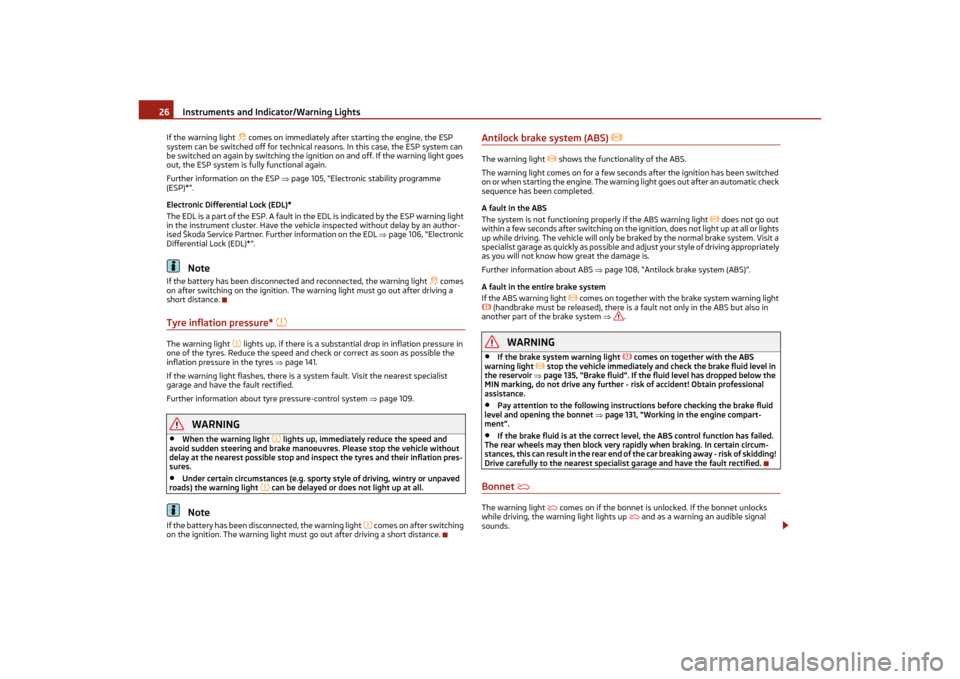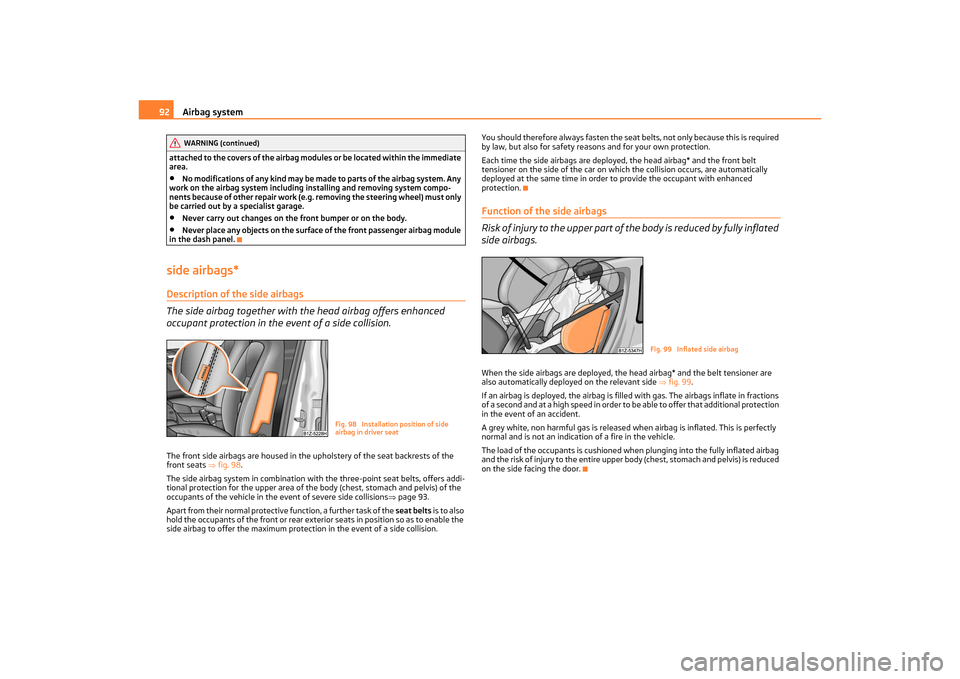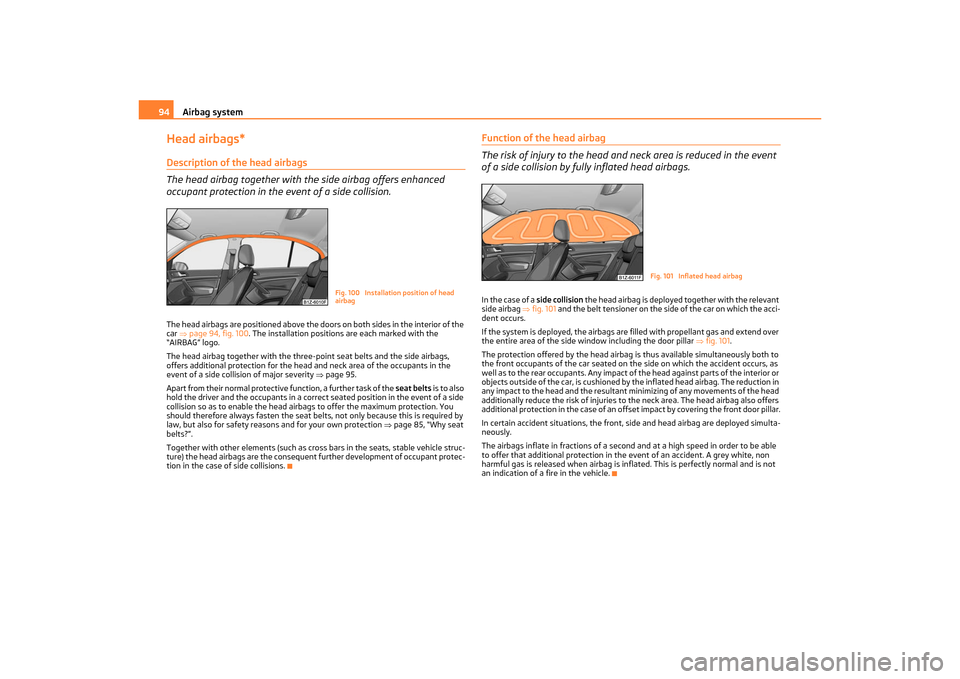2011 SKODA OCTAVIA TOUR flat tire
[x] Cancel search: flat tirePage 27 of 183

Instruments and Indicator/Warning Lights
26
If the warning light
comes on immediately after starting the engine, the ESP
system can be switched off for technical reasons. In this case, the ESP system can
be switched on again by switching the ignition on and off. If the warning light goes
out, the ESP system is fully functional again.
Further information on the ESP page 105, “Electronic stability programme
(ESP)*”.
Electronic Differential Lock (EDL)*
The EDL is a part of the ESP. A fault in the EDL is indicated by the ESP warning light
in the instrument cluster. Have the vehi cle inspected without delay by an author-
ised Škoda Service Partner. Further information on the EDL page 106, “Electronic
Differential Lock (EDL)*”.
Note
If the battery has been disconnected and reconnected, the warning light
comes
on after switching on the ignition. The wa rning light must go out after driving a
short distance.
Tyre inflation pressure*
The warning light
lights up, if there is a substantial drop in inflation pressure in
one of the tyres. Reduce the speed and check or correct as soon as possible the
inflation pressure in the tyres page 141.
If the warning light flashes, there is a system fault. Visit the nearest specialist
garage and have the fault rectified.
Further information about tyre pressure-control system page 109.
WARNING
•
When the warning light
lights up, immediately reduce the speed and
avoid sudden steering and brake manoeu vres. Please stop the vehicle without
delay at the nearest possible stop and inspect the tyres and their inflation pres-
sures.
•
Under certain circumstances (e.g. sporty style of driving, wintry or unpaved
roads) the warning light
can be delayed or does not light up at all.
Note
If the battery has been disconnected, the warning light
comes on after switching
on the ignition. The warning light must go out after driving a short distance.
Antilock brake system (ABS)
The warning light
shows the functionality of the ABS.
The warning light comes on for a few seconds after the ignition has been switched
on or when starting the engine. The warning light goes out after an automatic check
sequence has been completed.
A fault in the ABS
The system is not functioning pr operly if the ABS warning light
does not go out
within a few seconds after switching on the ignition, does not light up at all or lights
up while driving. The vehicle will only be braked by the normal brake system. Visit a
specialist garage as quickly as possible an d adjust your style of driving appropriately
as you will not know how great the damage is.
Further information about ABS page 108, “Antilock brake system (ABS)”.
A fault in the entire brake system
If the ABS warning light
comes on together with th e brake system warning light
(handbrake must be released), there is a fault not only in the ABS but also in
another part of the brake system .
WARNING
•
If the brake system warning light
comes on together with the ABS
warning light
stop the vehicle immediately and check the brake fluid level in
the reservoir page 135, “Brake fluid”. If the fluid level has dropped below the
MIN marking, do not drive any further - risk of accident! Obtain professional
assistance.
•
Pay attention to the following instruct ions before checking the brake fluid
level and opening the bonnet page 131, “Working in the engine compart-
ment”.
•
If the brake fluid is at the correct leve l, the ABS control function has failed.
The rear wheels may then block very ra pidly when braking. In certain circum-
stances, this can result in the rear end of the car breaking away - risk of skidding!
Drive carefully to the nearest specialist garage and have the fault rectified.
Bonnet
The warning light
comes on if the bonnet is unlocked. If the bonnet unlocks
while driving, the warning light lights up
and as a warning an audible signal
sounds.
s2lk.2.book Page 26 Monday, April 18, 2011 7:41 AM
Page 93 of 183

Airbag system
92
a t t a c h e d t o t h e c o v e r s o f t h e a i r b a g m o d u l e s o r b e l o c a t e d w i t h i n t h e i m m e d i a t e
area.•
No modifications of any kind may be ma de to parts of the airbag system. Any
work on the airbag system including installing and removing system compo-
nents because of other repair work (e.g. removing the steering wheel) must only
be carried out by a specialist garage.
•
Never carry out changes on the front bumper or on the body.
•
Never place any objects on the surface of the front passenger airbag module
in the dash panel.
side airbags*Description of the side airbags
The side airbag together with the head airbag offers enhanced
occupant protection in the event of a side collision.The front side airbags are housed in the upholstery of the seat backrests of the
front seats fig. 98 .
The side airbag system in combination with the three-point seat belts, offers addi-
tional protection for the upper area of th e body (chest, stomach and pelvis) of the
occupants of the vehicle in the event of severe side collisions page 93.
Apart from their normal protective function, a further task of the seat belts is to also
hold the occupants of the front or rear exterior seats in position so as to enable the
side airbag to offer the maximum protection in the event of a side collision. You should therefore always fasten the seat
belts, not only because this is required
by law, but also for safety reasons and for your own protection.
Each time the side airbags are deployed , the head airbag* and the front belt
tensioner on the side of the car on whic h the collision occurs, are automatically
deployed at the same time in order to provide the occupant with enhanced
protection.
Function of the side airbags
Risk of injury to the upper part of the body is reduced by fully inflated
side airbags.When the side airbags are deployed, the head airbag* and the belt tensioner are
also automatically deployed on the relevant side fig. 99 .
If an airbag is deployed, the airbag is fille d with gas. The airbags inflate in fractions
of a second and at a high speed in order to be able to offer that additional protection
in the event of an accident.
A grey white, non harmful gas is released when airbag is inflated. This is perfectly
normal and is not an indication of a fire in the vehicle.
The load of the occupants is cushioned when plunging into the fully inflated airbag
and the risk of injury to the entire upper body (chest, stomach and pelvis) is reduced
on the side facing the door.
WARNING (continued)
Fig. 98 Installation position of side
airbag in driver seat
Fig. 99 Inflated side airbag
s2lk.2.book Page 92 Monday, April 18, 2011 7:41 AM
Page 95 of 183

Airbag system
94
Head airbags*Description of the head airbags
The head airbag together with the side airbag offers enhanced
occupant protection in the event of a side collision.The head airbags are positioned above the d oors on both sides in the interior of the
car page 94, fig. 100 . The installation positions are each marked with the
“AIRBAG” logo.
The head airbag together with the three- point seat belts and the side airbags,
offers additional protection for the head and neck area of the occupants in the
event of a side collision of major severity page 95.
Apart from their normal protective function, a further task of the seat belts is to also
hold the driver and the occupants in a correct seated position in the event of a side
collision so as to enable the head airb ags to offer the maximum protection. You
should therefore always fasten the seat belts, not only because this is required by
law, but also for safety reasons and for your own protection page 85, “Why seat
belts?”.
Together with other elements (such as cross bars in the seats, stable vehicle struc-
ture) the head airbags are the consequent further development of occupant protec-
tion in the case of side collisions.
Function of the head airbag
The risk of injury to the head and neck area is reduced in the event
of a side collision by fully inflated head airbags.I n t h e c a s e o f a side collision the head airbag is deployed together with the relevant
side airbag fig. 101 and the belt tensioner on the side of the car on which the acci-
dent occurs.
If the system is deployed, the airbags are filled with propellant gas and extend over
the entire area of the side wi ndow including the door pillar fig. 101 .
The protection offered by the head airbag is thus available simultaneously both to
the front occupants of the car seated on th e side on which the accident occurs, as
well as to the rear occupants. Any impact of the head against parts of the interior or
objects outside of the car, is cushioned by the inflated head airbag. The reduction in
any impact to the head and the resultant minimizing of any movements of the head
additionally reduce the risk of injuries to the neck area. The head airbag also offers
additional protection in the ca se of an offset impact by covering the front door pillar.
In certain accident situations, the front, side and head airbag are deployed simulta-
neously.
The airbags inflate in fraction s of a second and at a high speed in order to be able
to offer that additional protection in th e event of an accident. A grey white, non
harmful gas is released when airbag is infl ated. This is perfectly normal and is not
an indication of a fire in the vehicle.
Fig. 100 Installation position of head
airbag
Fig. 101 Inflated head airbag
s2lk.2.book Page 94 Monday, April 18, 2011 7:41 AM